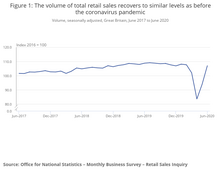Revenge buying
Revenge buying (also known as revenge shopping
Revenge buying began in China initially, and the trends were seen across the globe when economies reopened. The United States and Europe followed the same kind of enthusiasm in consumers, and luxury brands posted remarkable growth compared to during COVID lockdowns.[2][7]
Examples
In China, the Cultural Revolution during the 1960s and COVID-19 crisis nearly sixty years later are examples of collective traumas that resulted in revenge buying.[3] The phenomenon was first observed in the 1980s, where it was termed baofuxing xiaofei (Chinese: 报复性消费). Following China's 1976 opening to international trade, this term describes the sudden demand for foreign-brand goods.[5][8] It reoccurred in China in April 2020, when the lockdown was mostly lifted and markets reopened. At that time, the French luxury brand Hermès made US$2.7 million in sales in a single day.[4][9]
COVID-19 pandemic
The
The apparel industry suffered greatly during the pandemic; several notable retailers, including J. Crew, Neiman Marcus, J.C. Penney, Brooks Brothers, Ascena Retail Group, Debenhams, Arcadia Group, GNC, and Lord & Taylor, filed for bankruptcy.[12][13]

China was the first country hit by the COVID-19 pandemic; by the summer 2020, it had successfully contained community transmission and thereafter lifted significant restrictions.[15][16] The term revenge buying entered popular consciousness with the immediate economic recovery of the French fashion company Hermès, which recorded $2.7 million in sales at its flagship store in Guangzhou, China, on the day it reopened in April 2020, setting a record for most single-day shopping at any luxury outlet in China.[7] In addition to Hermès, lines piled up outside Apple, Gucci, and Lancôme stores.[9][4] A similar instance of revenge buying occurred in India following the relaxation of Omicron-related restrictions in March 2022.[17] A similar level of consumer enthusiasm was observed by the press in the United States and Europe after their economies mostly reopened in April 2021.[2]
Explanation
According to sociologists, compulsive and impulsive buying behaviors, such as panic buying and revenge buying, are
While revenge buying was first observed in China, it has since been observed in other countries. When physical stores reopened after the initial COVID lockdown, sales increased, particularly in luxury product stores. According to researchers for the International Journal of Social Psychiatry, the purchase of luxury goods acts as a means for consumers to repress unpleasant emotions.[5] Reactance theory is another analytical method sociologists use to gain a deeper understanding of revenge-buying behavior; this theory posits that when a threat or hindrance to a person's behavioral freedom makes them upset, the person will try to regain the threatened autonomy.[5][21]
See also
- Economic bubble
- Panic selling
- Consumer behaviour
- 2021 global inflation surge
References
- S2CID 245864500.
- ^ a b c Smith, Elliot (2 June 2021). "How to trade Europe's incoming 'revenge spend,' according to BlackRock". CNBC. Retrieved 23 November 2022.
- ^ a b c "Revenge buying". Philonomist. 12 May 2020. Retrieved 20 November 2022.
- ^ a b c "The 'revenge buying' syndrome: Here's why people will throng shops post the lockdown". The Times of India. 6 May 2020. Retrieved 20 November 2022.
- ^ S2CID 232230029.
- PMID 32834338.
- ^ a b Singh, Shelley. "The curious phenomenon of revenge shopping in China after lockdown". The Economic Times. Retrieved 23 November 2022.
- S2CID 249717780.
- ^ a b "What is Revenge Buying?". www.timesnownews.com. 30 May 2020. Retrieved 20 November 2022.
- ^ Kingson, Jennifer A. (6 July 2020). "The coronavirus is causing a slow-motion retail apocalypse". Axios. Retrieved 20 November 2022.
- ^ "Retail sales in China dropped by 20.5% after coronavirus hit, illustrating a scary difference between today's crisis and 2008". Business Insider. Retrieved 20 November 2022.
- ISSN 0190-8286. Retrieved 23 November 2022.
- ^ Thomas, Lauren (26 December 2020). "The 10 biggest retail bankruptcies of 2020". CNBC. Retrieved 23 November 2022.
- ^ "Retail sales, Great Britain – Office for National Statistics". www.ons.gov.uk. Retrieved 2 December 2022.
- PMID 32711779.
- PMID 34040464.
- ^ Babar, Kailash. "'Revenge shopping' helping malls fill up fast as Covid wanes". The Economic Times. Retrieved 23 November 2022.
- PMID 32413711.
- S2CID 229403038.
- S2CID 222077410.
- ISBN 978-0-12-129840-1, retrieved 20 November 2022
Further reading
- Zourrig, Haithem; Chebat, Jean-Charles; Toffoli, Roy (1 October 2009). "Consumer revenge behavior: A cross-cultural perspective". Journal of Business Research. Impact of Culture on Marketing Strategy. 62 (10): 995–1001. ISSN 0148-2963.
